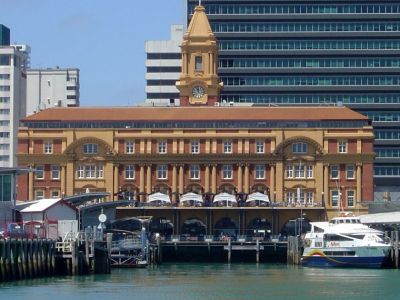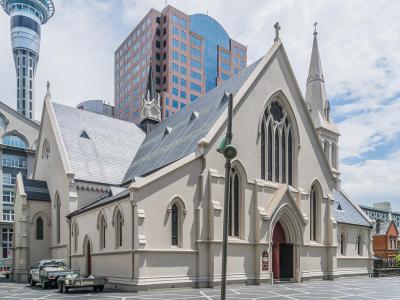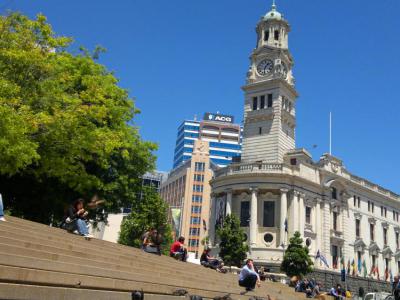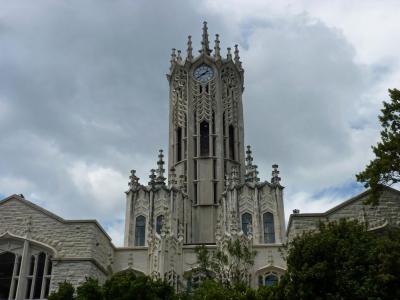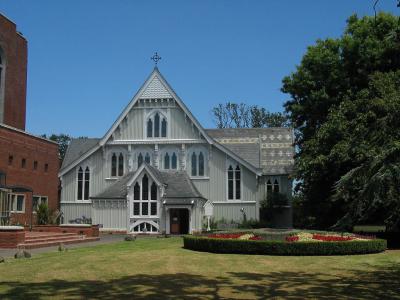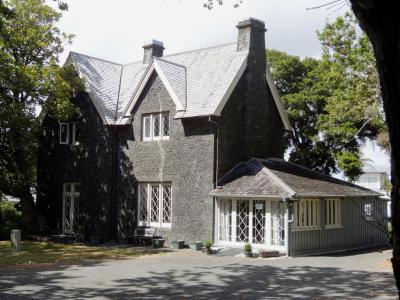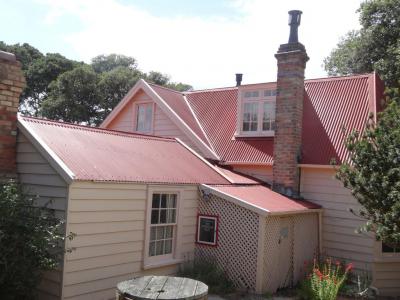
Auckland Historical Buildings Tour (Self Guided), Auckland
Auckland, New Zealand may not be known as a historical city, but it does contain some historical buildings all right. These old structures, dating back to the 19th century, reflect the diverse heritage and architectural evolution of the city and are cherished as landmarks.
The Ferry Building, an iconic waterfront edifice, is a fine example of Edwardian Baroque style. Built in 1912, it once served as the gateway to the city for passengers arriving by sea. Today, its striking clock tower remains a prominent feature on Auckland's skyline.
Saint Patrick's Cathedral, a lovely neo-Gothic sanctuary, is an enduring symbol of Auckland's Catholic heritage, in place since the 1840s.
The Town Hall, a grand Edwardian building completed in 1911, is a hub for cultural events and performances. Its elegant design and ornate interiors make it a cultural treasure in the heart of the city.
The University Clock Tower, located at the University of Auckland, is a symbol of higher education in the city. Built in 1926, it stands as a reminder of the institution's academic legacy and commitment to knowledge.
The Anglican Cathedral of Saint Mary's, constructed in the late 19th century, is a magnificent example of Victorian Gothic architecture – the world’s largest wooden Gothic structure.
Kinder House, a charming colonial villa dating back to 1857, offers a glimpse into Auckland's early settler history. It now serves as a museum, showcasing period furnishings and artifacts.
Finally, Ewelme Cottage, a picturesque timber cottage from the mid-19th century, is a hidden gem. Nestled in the Parnell neighborhood, it provides a window into domestic life during the colonial era.
Apart from being relics of the past, these historical buildings are vibrant elements of Auckland's cultural and architectural landscape. Exploring them offers a journey through time and a deeper understanding of the city's history. If you're an architecture lover or simply looking for a dose of nostalgia, be sure to include these landmarks on your Auckland itinerary.
The Ferry Building, an iconic waterfront edifice, is a fine example of Edwardian Baroque style. Built in 1912, it once served as the gateway to the city for passengers arriving by sea. Today, its striking clock tower remains a prominent feature on Auckland's skyline.
Saint Patrick's Cathedral, a lovely neo-Gothic sanctuary, is an enduring symbol of Auckland's Catholic heritage, in place since the 1840s.
The Town Hall, a grand Edwardian building completed in 1911, is a hub for cultural events and performances. Its elegant design and ornate interiors make it a cultural treasure in the heart of the city.
The University Clock Tower, located at the University of Auckland, is a symbol of higher education in the city. Built in 1926, it stands as a reminder of the institution's academic legacy and commitment to knowledge.
The Anglican Cathedral of Saint Mary's, constructed in the late 19th century, is a magnificent example of Victorian Gothic architecture – the world’s largest wooden Gothic structure.
Kinder House, a charming colonial villa dating back to 1857, offers a glimpse into Auckland's early settler history. It now serves as a museum, showcasing period furnishings and artifacts.
Finally, Ewelme Cottage, a picturesque timber cottage from the mid-19th century, is a hidden gem. Nestled in the Parnell neighborhood, it provides a window into domestic life during the colonial era.
Apart from being relics of the past, these historical buildings are vibrant elements of Auckland's cultural and architectural landscape. Exploring them offers a journey through time and a deeper understanding of the city's history. If you're an architecture lover or simply looking for a dose of nostalgia, be sure to include these landmarks on your Auckland itinerary.
How it works: Download the app "GPSmyCity: Walks in 1K+ Cities" from Apple App Store or Google Play Store to your mobile phone or tablet. The app turns your mobile device into a personal tour guide and its built-in GPS navigation functions guide you from one tour stop to next. The app works offline, so no data plan is needed when traveling abroad.
Auckland Historical Buildings Tour Map
Guide Name: Auckland Historical Buildings Tour
Guide Location: New Zealand » Auckland (See other walking tours in Auckland)
Guide Type: Self-guided Walking Tour (Sightseeing)
# of Attractions: 7
Tour Duration: 2 Hour(s)
Travel Distance: 4.6 Km or 2.9 Miles
Author: leticia
Sight(s) Featured in This Guide:
Guide Location: New Zealand » Auckland (See other walking tours in Auckland)
Guide Type: Self-guided Walking Tour (Sightseeing)
# of Attractions: 7
Tour Duration: 2 Hour(s)
Travel Distance: 4.6 Km or 2.9 Miles
Author: leticia
Sight(s) Featured in This Guide:
- Ferry Building
- Saint Patrick's Cathedral
- Town Hall
- University Clock Tower
- Anglican Cathedral of Saint Mary's
- Kinder House
- Ewelme Cottage
1) Ferry Building
The Auckland Ferry Terminal or simply Ferry Building is one of Auckland’s landmark buildings located right in the city’s downtown area. The site known as the Ferry Building is actually comprised of two parts known as the Old and New Buildings. The Old Building is constructed of sandstone in the Edwardian Baroque style and was completed in 1912. The impressive nature of the building demonstrates the importance of water transport in Auckland at the beginning of the 20th century. Originally the building was put to use as a terminal as well as space for the trade unions and consulate offices as well as those of the ferry companies, but in the 1980s it was refurbished and turned into retail space.
In recognition of the importance that the building holds in the growth, development and history of Auckland, it is now registered with the Historic Places Trust. Most of the actual ferry operations have now been moved to the New Building, which has modern piers and appropriate space for the current ferries in use today. The New Building was designed to appear as ships that are anchored behind the original Ferry Building. Auckland is one of the world’s great harbour cities and a stroll through the Ferry Building and a trip out onto the water are a must.
Tip:
Whether or not you're taking a cruise from Auckland, give yourself time to walk around and in this building.
Also, take the time to get yourself a very tasty gelato from the store there and enjoy the view at the harbor.
The outdoor seating facing the waterfront tops the experience off. Public restrooms are a few steps away.
In recognition of the importance that the building holds in the growth, development and history of Auckland, it is now registered with the Historic Places Trust. Most of the actual ferry operations have now been moved to the New Building, which has modern piers and appropriate space for the current ferries in use today. The New Building was designed to appear as ships that are anchored behind the original Ferry Building. Auckland is one of the world’s great harbour cities and a stroll through the Ferry Building and a trip out onto the water are a must.
Tip:
Whether or not you're taking a cruise from Auckland, give yourself time to walk around and in this building.
Also, take the time to get yourself a very tasty gelato from the store there and enjoy the view at the harbor.
The outdoor seating facing the waterfront tops the experience off. Public restrooms are a few steps away.
2) Saint Patrick's Cathedral
From modest beginnings in 1841 to the grand building you see before you today, Saint Patrick’s Cathedral in Auckland has always been the centre of Catholicism in the city. The land that the cathedral is built on was granted by the crown to the city’s first bishop Jean Baptiste Pompallier on June 1st, 1841. A simple wooden structure was first built to serve the 300 odd strong congregation that was mainly made up of Irish immigrants. It was clear that a more substantial building would be required and in 1845 an architect was commissioned to design a stone church. When Auckland was made a diocese in 1848, it was clear that a grander building would be required.
In 1884 the foundation stone was laid for extensive expansions to be made to the church and the old stone church became the transept. A new nave was added that included a bell tower and bells were imported directly from Rome. The new cathedral was officially opened on March 15, 1885 – just before Saint Patrick’s Day. Further expansions were carried out to make more space for the growing city’s congregation at the turn of the 20th century and the church that was completed in 1907 is the very same that you gaze upon today.
In 1884 the foundation stone was laid for extensive expansions to be made to the church and the old stone church became the transept. A new nave was added that included a bell tower and bells were imported directly from Rome. The new cathedral was officially opened on March 15, 1885 – just before Saint Patrick’s Day. Further expansions were carried out to make more space for the growing city’s congregation at the turn of the 20th century and the church that was completed in 1907 is the very same that you gaze upon today.
3) Town Hall
The Auckland Town Hall is one of the city’s best loved architectural masterpieces having served Auckland and its residents since it was inaugurated in 1911. The building was designed in an unusual layout in order to fit onto the wedge shaped land that had been put aside for the construction of a town hall. The neo-Baroque building is a five storey building that is constructed out of Omaru limestone and it was totally restored between 1994 and 1997 to ensure that the building continued to best serve the needs of the local population. During the restoration process the original stained glass windows and proscenium arch of the Concert Chamber were discovered and restored to their correct place.
The result of the renovations was a building that has stayed true to its original layout and design – with its kauri floors, ornate plasterwork, delicate stained windows and pressed metal ceiling. At the same time it is now able to offer world class concert halls and performance spaces. The Great Hall is able to seat around 1500 people on three levels and the Concert Chamber has seating for around 430 people on two levels. The pipe organ in the Town Hall is the largest musical instrument in the country.
The result of the renovations was a building that has stayed true to its original layout and design – with its kauri floors, ornate plasterwork, delicate stained windows and pressed metal ceiling. At the same time it is now able to offer world class concert halls and performance spaces. The Great Hall is able to seat around 1500 people on three levels and the Concert Chamber has seating for around 430 people on two levels. The pipe organ in the Town Hall is the largest musical instrument in the country.
4) University Clock Tower
Formerly known as the Old Arts building, the ClockTower was designed by R.A. Lippincott, an architect trained in Chicago who happened to be the brother-in-law of Walter Burley Griffin, the renowned designer of Canberra.
This 54-meter tall tower is constructed with Mount Somers stone and was inspired by the famous Tom Tower of Christ Church, Oxford. Over time, it has become a symbol of the University. Inside, there's an octagonal layout with vaulted ceilings, galleries, a mosaic floor, and supporting pillars.
For many years, the building served as the home to various academic departments including Arts, Architecture, Law, Music, and the Library, along with University Hall. The rear wing offered limited student facilities until the opening of the Student Union Building in 1968.
From 1985 to 1988, the main wing underwent extensive renovations, strengthening, and cleaning, restoring its original whiteness that led to its popular nickname, "the wedding cake." This significant reconstruction effort earned recognition from the Institute of Architects.
Today, the ClockTower houses the Vice-Chancellor, the Vice-Chancellor’s Office, the Equity Office, parts of Academic Services, the Great Hall, and the Council Room. It stands as the most iconic building of the University of Auckland and is open to the public at no charge.
This 54-meter tall tower is constructed with Mount Somers stone and was inspired by the famous Tom Tower of Christ Church, Oxford. Over time, it has become a symbol of the University. Inside, there's an octagonal layout with vaulted ceilings, galleries, a mosaic floor, and supporting pillars.
For many years, the building served as the home to various academic departments including Arts, Architecture, Law, Music, and the Library, along with University Hall. The rear wing offered limited student facilities until the opening of the Student Union Building in 1968.
From 1985 to 1988, the main wing underwent extensive renovations, strengthening, and cleaning, restoring its original whiteness that led to its popular nickname, "the wedding cake." This significant reconstruction effort earned recognition from the Institute of Architects.
Today, the ClockTower houses the Vice-Chancellor, the Vice-Chancellor’s Office, the Equity Office, parts of Academic Services, the Great Hall, and the Council Room. It stands as the most iconic building of the University of Auckland and is open to the public at no charge.
5) Anglican Cathedral of Saint Mary's
The Anglican Cathedral of Saint Mary’s in Auckland is thought to be the world’s largest wooden Gothic construction. The foundation stone was laid in 1886 and although the cathedral was originally designed to be built in stone, during the economic downturn of the late 19th century, this was considered to be too expensive. The Gothic Revival building draws upon the finest elements of medieval design and was the final large project for the eminent local architect Benjamin Woolfield Mountfort. The cathedral was consecrated on August 25, 1898 by Bishop Cowie.
The lengthy building has many striking gables and impressive lancet shaped windows, the lack of trusses due to the nature of the building also makes the interior seem open and very spacious. In 1982 an engineering feat was undertaken when the cathedral in its entirety was transported from its original site on a system of rollers across to the new Holy Trinity Cathedral Complex. Today the Anglican Cathedral of Saint Mary’s is located together with the Holy Trinity and the Bishop Monteith Visitor’s Centre. You are free to visit the cathedral from Tuesday to Friday from 10am to 3pm or by prior arrangement, there are also many services held throughout the week.
The lengthy building has many striking gables and impressive lancet shaped windows, the lack of trusses due to the nature of the building also makes the interior seem open and very spacious. In 1982 an engineering feat was undertaken when the cathedral in its entirety was transported from its original site on a system of rollers across to the new Holy Trinity Cathedral Complex. Today the Anglican Cathedral of Saint Mary’s is located together with the Holy Trinity and the Bishop Monteith Visitor’s Centre. You are free to visit the cathedral from Tuesday to Friday from 10am to 3pm or by prior arrangement, there are also many services held throughout the week.
6) Kinder House
The Kinder House, located on historic Ayr Street, is one of Auckland’s oldest and most important buildings. The two storey residence was built as the home of Reverend John Kinder, who is today recognized as one of the city’s most important colonial figures. Kinder immigrated to Auckland in 1855 to take up the post of master at the Church of England Grammar School. As well as for his role as a master, Kinder is also noted as one of New Zealand’s most talented and prolific 19th century artists. The house was built for Kinder and his family (his mother and sister) in 1857 under commission by the Anglican Church.
When Kinder married in 1859 his wife, Celia, came to live in this stone home as well. The historic residence where he spent many happy years was also the subject of much of Kinder’s art and photography attempts. Some of his photos have survived 150 years and are important historical documents today. You can also see much of his art work on display on the ground floor of the historic home. Kinder House is managed by the Kinder House Society and is open to the public Wednesday through to Sunday from 12 to 3pm.
When Kinder married in 1859 his wife, Celia, came to live in this stone home as well. The historic residence where he spent many happy years was also the subject of much of Kinder’s art and photography attempts. Some of his photos have survived 150 years and are important historical documents today. You can also see much of his art work on display on the ground floor of the historic home. Kinder House is managed by the Kinder House Society and is open to the public Wednesday through to Sunday from 12 to 3pm.
7) Ewelme Cottage
Ewelme Cottage, one of Auckland’s oldest remaining buildings, dates from 1863 when it was built for the Rev Vicesimus Lush and his family upon their arrival in the colony. The cottage, which is run by the Historic Places Trust, is a true historical gem since it remained in the Lush family until the 1960s and retains many of the family’s belongings and furnishings dating back to Victorian times. The architecture of the home is distinctive, given that it is laid out in a manner that was common in medieval Britain – it is thought that this may have been done to reflect the sombre and pious sensibilities of the time.
One of the highlights of the family’s possessions is the antique book collection with more than 2000 tomes. The cottage offers a snapshot into life in New Zealand during the first days of the colony – you will see much of the home preserved as it was in the 19th century and many cooking, craft and even beauty items and pharmaceuticals. Rooms of the home were used during the filming of the Oscar winning film The Piano. Ewelme Cottage is open from Friday to Sunday, 10am to 4:30pm.
One of the highlights of the family’s possessions is the antique book collection with more than 2000 tomes. The cottage offers a snapshot into life in New Zealand during the first days of the colony – you will see much of the home preserved as it was in the 19th century and many cooking, craft and even beauty items and pharmaceuticals. Rooms of the home were used during the filming of the Oscar winning film The Piano. Ewelme Cottage is open from Friday to Sunday, 10am to 4:30pm.
Walking Tours in Auckland, New Zealand
Create Your Own Walk in Auckland
Creating your own self-guided walk in Auckland is easy and fun. Choose the city attractions that you want to see and a walk route map will be created just for you. You can even set your hotel as the start point of the walk.
Auckland Introduction Walking Tour
Owing to their remoteness, the islands of New Zealand were the last large habitable lands to be settled by humans. Maori began to inhabit this area around 1350 and they called it "desired by many", referring to its abundant natural resources.
In 1840, after purchasing land from the local tribe, the British established Auckland as a colonial settlement. Its first governor, Lieutenant... view more
Tour Duration: 2 Hour(s)
Travel Distance: 4.8 Km or 3 Miles
In 1840, after purchasing land from the local tribe, the British established Auckland as a colonial settlement. Its first governor, Lieutenant... view more
Tour Duration: 2 Hour(s)
Travel Distance: 4.8 Km or 3 Miles
Useful Travel Guides for Planning Your Trip
Souvenir Shopping Guide: 17 Kiwi Things to Buy in Auckland
Although closer than it used to be, courtesy of “The Lord of the Rings” movie trilogy, New Zealand still remains below “Down Under” to many. If you're privileged to visit Auckland, make sure to bring home something memorable to “extend” your trip. Here are some ideas for signature...
The Most Popular Cities
/ view all
